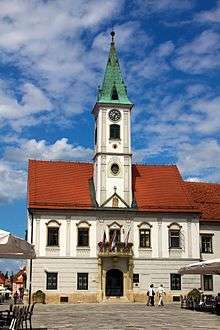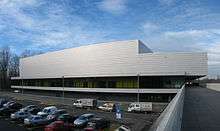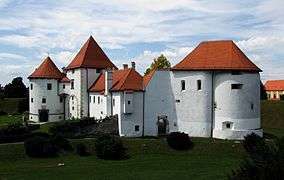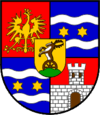Varaždin
| Varaždin | ||||||
|---|---|---|---|---|---|---|
| City | ||||||
Top: Varaždin Castle; Center left: Korzo; Center right: Croatian National Theater; Bottom: Varaždin Arena | ||||||
| ||||||
| Motto: Probitati et bonis artibus | ||||||
 Varaždin Location of Varaždin within Croatia | ||||||
| Coordinates: 46°18′N 16°20′E / 46.300°N 16.333°ECoordinates: 46°18′N 16°20′E / 46.300°N 16.333°E | ||||||
| Country |
| |||||
| County |
| |||||
| Government | ||||||
| • Mayor | Goran Habuš (HNS-LD) | |||||
| Area | ||||||
| • City | 59.45 km2 (22.95 sq mi) | |||||
| • Urban | 34.22 km2 (13.21 sq mi) | |||||
| Elevation | 173 m (568 ft) | |||||
| Population (2011)[1] | ||||||
| • City | 46,946 | |||||
| • Density | 790/km2 (2,000/sq mi) | |||||
| • Urban | 38,839 | |||||
| • Urban density | 1,100/km2 (2,900/sq mi) | |||||
| Time zone | CET (UTC+1) | |||||
| • Summer (DST) | CEST (UTC+2) | |||||
| Postal code | 42 000 | |||||
| Area code(s) | 042 | |||||
| Patron saints | St. Nicholas | |||||
| Website | varazdin.hr | |||||
Varaždīn (Croatian pronunciation: [ʋâraʒdiːn] or [ʋarǎʒdin]; also known by other alternative names) is a city in Northern Croatia, 81 km (50 mi) north of Zagreb. The total population is 46,946, with 38,839 on 34.22 km2 (13.21 sq mi) of the city settlement itself (2011).[1] The centre of Varaždin County is located near the Drava river, at 46°18′43″N 16°21′40″E / 46.312°N 16.361°E. It is mainly known for its baroque buildings, music,[2] textile, food and IT industry.[3]
Name
In Hungarian the town is known as Varasd, in Latin as Varasdinum, and in German as Warasdin. The name Varaždin traces its origin in the word varoš, a Hungarian loanword.[4]
Population
The total population of the city is 46,946 and it includes the following settlements:[1]
- Črnec Biškupečki, population 696
- Donji Kućan, population 716
- Gojanec, population 620
- Gornji Kućan, population 1,139
- Hrašćica, population 1,283
- Jalkovec, population 1,309
- Kućan Marof, population 1,388
- Poljana Biškupečka, population 452
- Varaždin, population 38,839
- Zbelava, population 504
The total area is 59.45 km2 (22.95 sq mi) (2001).
History


The first written reference to Varaždin, whose historical name is Garestin, was on 20 August 1181, when King Béla III mentioned the nearby thermal springs (Varaždinske Toplice) in a legal document.[5]
Varaždin was declared a free royal borough in 1209 by the Hungarian King Andrew II. The town became the economic and military centre of northern Croatia. Due to Ottoman raids, the town was structured defensively around the old fortress, and acquired the shape of a typical medieval Wasserburg. In the early 13th century, the Knights Hospitaller (Croatian: Ivanovci) came to Varaždin, where they built the church and a monastery.[5]
At the end of the 14th century, Varaždin fortress passed to the hands of the Counts of Celje. Over the following centuries Varaždin had several owners, the most influential being Beatrice Frankopan, Margrave Georg of Brandenburg, who built the town hall; the last was Baron Ivan Ungnad, who reinforced the existing fortification. At the end of the 16th century Count Thomas Erdödy became its owner, assuming the hereditary position of Varaždin prefects (župan), and the fortress remained in the ownership of the Erdödy family until 1925.

In 1756, the Ban Francis Nadásdy chose Varaždin as his official residence, and Varaždin became the capital of all of Croatia. It hosted the Croatian Sabor and the Royal Croatian Council founded by Empress Maria Theresa.
The periods of the Reformation and the counter-reformation had a great influence on Varaždin. With the arrival of the Jesuits, the school (gymnasium) and the Jesuit house were founded, and churches and other buildings were built in the Baroque style. In the 18th century Varaždin was the seat of many Croatian noblemen, and in 1756 it became the Croatian administrative centre. The fire of 1776 destroyed most of the town, resulting in the administrative institutions moving back to Zagreb.[5]
Varaždin was the seat of the Varaždin County of the Kingdom of Croatia-Slavonia within the Austro-Hungarian monarchy, ruled by the Kingdom of Hungary after the compromise of 1867. The Hungarian stamp, issued in 1881 shows both names.
By the 19th century Varaždin had been completely rebuilt and expanded, with flourishing crafts and trade, and later the manufacture of silk and bricks. The theatre, music school, and fire department were founded.
In the 20th century Varaždin developed into the industrial centre of Northwestern Croatia. The textile manufacturer Tivar was founded in 1918. In the Croatian War of Independence, 1991, Varaždin suffered directly for only for a few days, because the huge Yugoslav People's Army base quickly surrendered, resulting in a minimal number of casualties, and providing weapons (worth $600m) for the Croatian army.
Monuments and Sights
Varaždin represents the best preserved and richest urban complex in continental Croatia.

The Old Town (fortress) is an example of medieval defensive buildings. Construction began in the 14th century, and in the following century the rounded towers, typical of Gothic architecture in Croatia, were added. Today it houses the Town Museum. The fortress is depicted on the reverse of the Croatian 5 kuna banknote, issued in 1993 and 2001.[6]
The Old and Contemporary Masters Gallery is located in the Sermage Palace, built in the rococo style in 1750.
In 1523, Margrave Georg of Brandenburg built the town hall in late baroque style, with the Varaždin coat of arms at the foot of the tower, and it has continued in its function until the present day. There is a guard-changing ceremony every Saturday.
Varaždin's Cathedral, a former Jesuit church, was built in 1647, and is distinguished by its baroque entrance, eighteenth-century altar, and paintings.
There are many baroque and rococo palaces and houses in the town. Worth particular mention is Varaždin's Croatian National Theatre, built in 1873 and designed by the famous Viennese architects Herman Helmer and Ferdinand Fellner.
A baroque music festival has been held annually in Varaždin since 1971, and attracts some of the finest musicians and their fans from Croatia and the world. Recommended to visitors is also the historical street festival Špancir fest every September.
The city features its old city guard, named Purgari, in various city ceremonies as well as the weekly ceremony of the 'change of the guards' in front of the city hall. Additionally, Varaždin police officers patrol on bicycles in the warmer months.[7]
The Old Town (Stari Grad)
The Old Town keep is one of the biggest monuments in the city of Varaždin and one of its biggest tourist attractions. It is located in the north-western section of the city core. Today the keep houses the Varaždin City Museum.
The keep is first mentioned in the 12th century and it is believed to be the center of Varaždin county life. The keep underwent numerous ownership changes and reconstructions over the centuries.
The Old Town was featured on the now defunct 5 Kuna bill. Interestingly, on the bill the picture of the keep is a mirror image of the actual appearance of the keep.
Churches and monasteries

|
|
Baroque palaces
|
Varaždin cemetery
The cemetery date back to 1773 and it was long time an ordinary place until 1905, when Herman Haller had an idea to make it more beautiful and park-like with large trees and alleys for citizens to stroll through. The reconstruction of the cemetery was done between 1905 and 1947 when it got the form for which it later became one of the most beautiful cemeteries in Europe. It is an outstanding example of landscape architecture and protected cultural and natural park.
Festivals
- Špancirfest
- Varaždin Baroque Evenings
- International Children and Youth Animation Film Festival VAFI, since 2010 .
Museums
- THE OLD TOWN (STARI GRAD) Museum houses the Cultural and Historic Collection. The Old Town Museum has been a part of the Varaždin City Museum organization since 1925. Today is features: over 400 pieces from the glass, ceramics and clocks collection, 10 rooms furnished in chronological period style (renaissance, baroque, rococo, Empire, Biedermeier, historicism and art deco), a chapel and sacristy, and 2 rooms dedicated to two prominent men from Varaždin, Vatroslav Jagić and Ivan Kukuljević Sakcinski.
- THE HERZER PALACE houses the Entomological Collection focusing on The World of Insects. There are over 4500 exhibits which clearly show the biology of bugs through several topics:In the forest, Near the forest and on the meadow, In the water and near the water, At night and underground.
- THE SERMAGE PALACE houses the Gallery of Old and Contemporary Masters Art Gallery. It is home to over 5300 works of art separated in 10 collections with works ranging from the 15th to the 20th century.
Transportation
Road access
Varaždin is connected with A4 highway which runs between Zagreb (south) and Čakovec / Hungarian border (just north). Varaždin and Zagreb are also connected with state road D3 which serves as an alternative to tolled highway. In Novi Marof, just south from Varaždin, state road D24 (which represents connection of Varaždin with majority of Krapina-Zagorje County located south-west from the town) connects with D3 road from the west. D3 also run further north from Varaždin, representing state road connection with Međimurje -northernmost part of the country (largest destination served being Čakovec).
Major state road which connects Varaždin with north-east and east part of the country (serving regions Podravina and Slavonia, one of the largest destinations served being Ludbreg, Koprivnica, Virovitica and Osijek) is state road D2. D2 also connects Varaždin with Croatian-Slovenian border at Dubrava Križovljanska, located just north-east. Varaždin is also connected with Krapina-Zagorje County via D35 road, which run south-west from Varaždin, but more north than D24. Regarding larger destinations, this road is a major connection of Varaždin with Ivanec, Lepoglava and Krapina.
D2 and D3 roads are also part of bypass which encircles the town.
The town is also hub for bus transportation enterprise "AP Varaždin" which offers regional, distant (multi-regional) and occasional passenger bus transportation service between Varaždin and large number of towns across the country, but also offers international lines.
Railway access
Varaždin's railway station is one of the largest and most important train stations in northern Croatia. It represents the intersection of three Croatian railway corridors which are used for both passenger and freight traffic. All of the rail corridors which start or end in Varaždin are single-tracked and non-electrified. It is the terminus for one local line (L201 connecting Golubovec), one regional line (R202 connecting Dalj via Koprivnica, Virovitica and Osijek) and also lies on R201 line through which trains directly connect the town with Zagreb and most of Krapina-Zagorje County (on south) and with Međimurje County (just north).
Although the largest number of direct passenger trains from Zagreb to Varaždin run via the R201 corridor (through the north-western part of the country), an alternative way to travel by train between those two cities is via the R202 line between Varaždin and Koprivnica, and the M201 line between Koprivnica and Zagreb (through the north-eastern part of the country). Although this route requires transfer in Koprivnica in the majority of cases, journeys by this route may take shorter travel time.
Public transportation
Taxis are the only part of public transportation inside the town districts.
Climate
| Climate data for Varaždin | |||||||||||||
|---|---|---|---|---|---|---|---|---|---|---|---|---|---|
| Month | Jan | Feb | Mar | Apr | May | Jun | Jul | Aug | Sep | Oct | Nov | Dec | Year |
| Record high °C (°F) | 19.1 (66.4) |
21.6 (70.9) |
25.3 (77.5) |
30.4 (86.7) |
33.2 (91.8) |
36.0 (96.8) |
39.3 (102.7) |
39.4 (102.9) |
32.9 (91.2) |
27.7 (81.9) |
24.3 (75.7) |
21.4 (70.5) |
39.4 (102.9) |
| Average high °C (°F) | 3.4 (38.1) |
6.1 (43) |
11.1 (52) |
15.7 (60.3) |
20.9 (69.6) |
23.9 (75) |
26.0 (78.8) |
25.8 (78.4) |
21.5 (70.7) |
15.5 (59.9) |
8.6 (47.5) |
4.4 (39.9) |
15.2 (59.4) |
| Daily mean °C (°F) | −0.2 (31.6) |
1.6 (34.9) |
5.8 (42.4) |
10.3 (50.5) |
15.4 (59.7) |
18.5 (65.3) |
20.2 (68.4) |
19.5 (67.1) |
15.4 (59.7) |
10.0 (50) |
4.6 (40.3) |
1.0 (33.8) |
10.2 (50.4) |
| Average low °C (°F) | −3.7 (25.3) |
−2.5 (27.5) |
1.0 (33.8) |
4.7 (40.5) |
9.2 (48.6) |
12.6 (54.7) |
14.1 (57.4) |
13.5 (56.3) |
10.0 (50) |
5.5 (41.9) |
1.0 (33.8) |
−2.2 (28) |
5.3 (41.5) |
| Record low °C (°F) | −26.8 (−16.2) |
−28 (−18) |
−23.4 (−10.1) |
−5.5 (22.1) |
−2.3 (27.9) |
2.2 (36) |
4.7 (40.5) |
3.2 (37.8) |
−3.1 (26.4) |
−7.5 (18.5) |
−19.6 (−3.3) |
−22.7 (−8.9) |
−28 (−18) |
| Average precipitation mm (inches) | 38.9 (1.531) |
42.0 (1.654) |
50.9 (2.004) |
63.1 (2.484) |
71.8 (2.827) |
96.5 (3.799) |
91.2 (3.591) |
88.0 (3.465) |
84.7 (3.335) |
80.6 (3.173) |
77.0 (3.031) |
58.3 (2.295) |
843.1 (33.193) |
| Average precipitation days (≥ 0.1 mm) | 9.2 | 9.3 | 10.9 | 12.9 | 13.2 | 14.0 | 12.1 | 10.9 | 10.3 | 10.4 | 11.1 | 11.2 | 135.4 |
| Average snowy days (≥ 1.0 cm) | 13.5 | 9.9 | 3.4 | 0.5 | 0.0 | 0.0 | 0.0 | 0.0 | 0.0 | 0.0 | 3.7 | 9.4 | 40.4 |
| Average relative humidity (%) | 84.1 | 78.6 | 73.2 | 69.1 | 69.6 | 70.9 | 71.7 | 74.8 | 79.3 | 81.7 | 84.7 | 85.7 | 76.9 |
| Mean monthly sunshine hours | 77.5 | 113.0 | 148.8 | 180.0 | 238.7 | 246.0 | 279.0 | 260.4 | 195.0 | 139.5 | 84.0 | 65.1 | 2,027 |
| Percent possible sunshine | 30 | 43 | 45 | 49 | 57 | 59 | 65 | 65 | 57 | 47 | 34 | 29 | 51 |
| Source: Croatian Meteorological and Hydrological Service[8][9] | |||||||||||||
Economy
Varaždin is one of the few Croatian cities whose industry did not directly suffer from the war in 1991. Besides textile giant Varteks, it also has nationally important food (Vindija), metal, and construction industries. The Information Technology and financial and banking sector as are well developed. Further economic development has been encouraged with the creation of a free investment zone.[3]
The city of Varaždin is easily accessible by major roads from all sides. The road infrastructure is good and the main highway connection is A4, connecting the Hungary border-crossing point in Goričan with Zagreb, as well as the coast of the Adriatic Sea via A1/A6. A2 is also accessible through the Zagorje region. In addition to the highways, there is also an east-west state route connecting the city to the Slovenian border, and Koprivnica, Osijek and the east part of Croatia. The city is connected to the suburbs and villages surrounding it with a public transportation system of buses. The city also has a train and bus station, which are both located about a 10-minute walk from the center. The trains are mainly used for cargo, due to the lack of investment in the country's train infrastructure. Varaždin's bus service is of high quality and use, it offers regular service to many local, domestic and international routes, as well as many additional seasonal routes to the Adriatic Sea. There is also taxi service available on-call which is situated by the bus station. In the outskirts of the city there is also a small recreational airport, used mainly for sightseeing and farming purposes.
Tourism

Today Varaždin is a popular destination for the summer holidays. The city has numerous areas of interests ranging from cultural areas (reflected by many museums, galleries and theaters in the area), shopping centers in the downtown core, various sports and recreation facilities, also a rich history in cuisine. The close of the tourist season is marked by two annual festivals. The annual ŠpancirFest begins at the end of August and ends in September (lasts for 10 days). At this time. the city welcomes artists, street performers, musicians and vendors for what is called "the street walking festival".
The city also hosts the Varaždin Baroque Evenings festival, first held in 1971. The festival honours baroque music and culture, both of which hold a special place in Varaždin's identity.
Varaždin is also the host of the Radar Festival, which hosts concerts at the end of summer. It has already hosted various popular artists as Bob Dylan, Carlos Santana, The Animals, Manic Street Preachers, Solomon Burke and many others.[10][11]
Sport

Varaždin is a city of numerous professional and semi-professional sports clubs. Varaždin Arena, located near the Drava River, was one of the hosts of the 2009 World Men's Handball Championship held in Croatia.
- Football: NK Varaždin ŠN, NK Varteks
- Handball: RK Varteks Di Caprio, RK Koka
- Basketball: KK Vindi
- Volleyball: OK Varaždin
- Tennis: TK Varaždin
- BK Vindija
- KK Varteks
- Hockey: "KHL Varaždin"
- Wrestling: "Vindija"
- Waterpolo: "Coning"
- Badminton: "BK KAJ"
- Bicycling: "BD Sloga"
- Track and Field: "TK Marathon 95"
Education
Varaždin has a rich and developed system of education, especially for a city of its size. It has seven elementary schools, 10 high schools (2 public gymnasiums, 2 private gymnasiums, trade schools, and other specialized high schools for various paths), 4 higher schools (equivalent to college) and 2 faculties (Faculty of Organization and Information Technology and Geotechnical faculty) that are part of the University of Zagreb.
Notable people


This list contains some of the notable people who were either born in Varaždin, lived in the city for a longer time or were in some significant way related to it.
- Ivan Belostenec - linguist, lexicographer[12]
- Slavko Brankov - actor
- Mirko Breyer - Croatian writer, bibliographer, antiquarian,[13][14] and one of the notable alleged and false victims of the Stara Gradiška concentration camp[15]
- Baltazar Dvorničić Napuly - Catholic cleric and lawyer[16]
- Juraj Habdelić - writer[17]
- Hermann II of Celje - count
- Branko Ivanković - football manager
- Vatroslav Jagić - philologist, linguist
- Marija Jurić Zagorka - journalist, dramatist and novelist
- Ljubomir Kerekeš - actor
- Vjekoslav Klaić - writer and historian
- Ferdinand Konščak - explorer, cartographer
- Željko Krajan - tennis coach and former player
- Ivan Kukuljević Sakcinski - historian, politician, writer
- Samuel Louis Mosinger - prominent businessman, merchant and member of the "Varaždin charity society"
- Miljenko Mumlek - footballer
- Ivan Padovec - guitar virtuoso
- Franjo Rački - historian, politician and writer
- Vjekoslav Rosenberg-Ružić - composer, conductor and music educator
- Silvester Sabolčki - footballer
- Tadija Smičiklas - historian and politician
- Ignacije Szentmartony - theologian
- Ksaver Šandor Gjalski - writer and civil servant
- Karolina Šprem - tennis player
- Krsto Ungnad - baron/mayor
- Željko Vincek - track and field athlete
- Davor Vugrinec - footballer
- Johann Baptist Wanhal - composer
- Robert Herjavec - businessman, investor, and television personality
- Radoslav Rogina - cyclist
- Kristijan Đurasek - cyclist
- Franjo Košćec - ethimologist, founder of "Ethimological Collection" (Bugs museum - the largest in Europe), science professor
- Marko Rog - footballer
International relations
Twin towns — Sister cities
Varaždin is twinned with:
|
See also
- Roman Catholic Diocese of Varaždin
- Tentative list of World Heritage Sites in Croatia
- Varaždin County (former)
Notes
- 1 2 3 "Population by Age and Sex, by Settlements, 2011 Census: Varaždin". Census of Population, Households and Dwellings 2011. Zagreb: Croatian Bureau of Statistics. December 2012.
- ↑ "Varazdin: Croatia's 'little Vienna'". Telegraph.
- 1 2 "Varaždin County". ICPR3.
- ↑ "Hrvatski jezični portal - Varaždin". HJP.
- 1 2 3 "Varaždin history". varazdin.hr.
- ↑ Croatian National Bank. Features of Kuna Banknotes: 5 kuna (1993 issue) & 5 kuna (2001 issue). – Retrieved on 30 March 2009.
- ↑ "The Varaždin Civil Guard 'Purgari'". Tourism-Varaždin.
- ↑ "Varaždin Climate Normals" (PDF). Croatian Meteorological and Hydrological Service. Retrieved 2 December 2015.
- ↑ "Mjesečne vrijednosti za Varaždin u razdoblju1949−2014" (in Croatian). Croatian Meteorological and Hydrological Service. Retrieved 3 December 2015.
- ↑ "Radar festival 2008: Bob Dylan, Manic Street Preachers, Majke, Drago Mlinarec & Vlado Kreslin" (in Croatian). Retrieved 29 April 2014.
- ↑ "Radar festival: Santana, Solomon Burke, Eric Burdon and The Animals, Joe Jackson, Zoran Predin & Lačni Franz, Voodoo Lizards, Tripdavon" (in Croatian). Retrieved 29 April 2014.
- ↑ "Belostenec, Ivan" (in Croatian). Miroslav Krleža Institute of Lexicography. Retrieved 29 April 2014.
- ↑ Ivo Goldstein (2005, pp. 92, 172, 173, 174, 175, 176)
- ↑ Ivo Goldstein (2001, pp. 264, 265)
- ↑ "Jasenovački popis: Manipulacije s poznatima i slavnima" (in Croatian). Retrieved 2016-04-30.
- ↑ "Dvorničić Napuly, Baltazar" (in Croatian). Miroslav Krleža Institute of Lexicography. Retrieved 29 April 2014.
- ↑ "Habdelić, Juraj" (in Croatian). Miroslav Krleža Institute of Lexicography. Retrieved 29 April 2014.
- ↑ "Međunarodna suradnja Grada Pule". Grad Pula (in Croatian and Italian). Archived from the original on 2012-05-05. Retrieved 2013-07-28.
Sources
- Cresswell, Peterjon; Atkins, Ismay; Dunn, Lily (10 July 2006). Time Out Croatia (First ed.). London, Berkeley & Toronto: Time Out Group Ltd & Ebury Publishing, Random House Ltd. 20 Vauxhall Bridge Road, London SV1V 2SA. ISBN 978-1-904978-70-1. Retrieved 10 March 2010.
External links
| Wikimedia Commons has media related to Varaždin. |
| Wikivoyage has a travel guide for Varaždin. |
- (Croatian) varazdin.hr – Official website
- (English) varazdin.hr/en – Official website
- Varaždin City Museum - official website
- eVarazdin.hr - daily city e-newspapers
- Varaždin Online — News from Varaždin, up-dated daily
- Varaždin Trg Kralja Tomislava Live




.gif)

